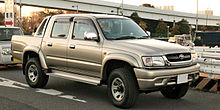Toyota Hilux
| Toyota Hilux | |
|---|---|
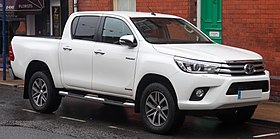 2016 Toyota Hilux Invincible (GUN125R) | |
| Overview | |
| Manufacturer | Toyota |
| Also called | Toyota Pickup (United States) |
| Production | March 1968 – present |
| Body and chassis | |
| Class |
|
| Chronology | |
| Predecessor |
|
| Successor | Toyota Tacoma (North America) |
The Toyota Hilux (Japanese: トヨタ・ハイラックス, romanized: Toyota Hairakkusu; stylized as HiLux and historically as Hi-Lux) is a series of pickup trucks produced and marketed by the Japanese automobile manufacturer Toyota. The majority of these vehicles are sold as pickup truck or cab chassis variants, although they could be configured in a variety of body styles. The pickup truck was sold with the HiLux name in most markets, but in North America, the Hilux name was retired in 1976 in favor of Truck, Pickup Truck, or Compact Truck. In North America, the popular option package, the SR5 (Sport Runabout 5-Speed), was colloquially used as a model name for the truck, even though the option package was also used on other Toyota models, like the 1972 to 1979 Corolla. In 1984, the Toyota Trekker, the camper version of the Hilux, was renamed the 4Runner in Venezuela, Australia and North America, and the Hilux Surf in Japan. In 1992, Toyota introduced a new pickup model, the midsize Toyota T100 in North America, necessitating distinct names for each vehicle other than Truck and Pickup Truck. The 4Runner is now a full SUV, and the more recent models of the Hilux are separate in appearance from the Tacoma. In 2019, Toyota revealed plans to introduce an EV HiLux within six years.[2]
First generation (N10; 1968)[]
| First generation (N10) | |
|---|---|
 | |
| Overview | |
| Production | March 1968 – April 1972 |
| Assembly | Japan: Hamura, Tokyo (Hino) |
| Designer | Takayuki Otsuka[3] |
| Body and chassis | |
| Body style | 2-door truck |
| Layout | Front-engine, rear-wheel-drive |
| Powertrain | |
| Engine |
|
| Transmission | 4-speed manual |
| Dimensions | |
| Length | 4,300–4,690 mm (169.3–184.6 in)[4] |
| Width | 1,610 mm (63.4 in)[4] |
| Height | 1,560–1,565 mm (61.4–61.6 in)[4] |
| Curb weight | 1,050–1,085 kg (2,314.9–2,392.0 lb)[4] |
The Hilux started production in March 1968[5] as the RN10 in short-wheelbase form with a 1.5 L inline-four engine, generating a maximum power output of 77 PS (57 kW; 76 hp) in Japanese market specification. In Japan, it was available at the Toyota Japan dealership retail chains called Toyota Store and Toyopet Store. The modification to the engine was enough for a claimed top speed of 130 km/h (81 mph).[6] The 1.5-litre engine was upgraded to a 1.6 L inline-four in February 1971.
In April 1969, a long-wheelbase version was added to the range. The short-wheelbase version also continued in production for many more years.[citation needed] The long-wheelbase version was not sold in the North American market until 1972, allowing the Datsun Truck to maintain a strong market presence. The Hilux was offered as a replacement to the Toyota Crown, Toyota Corona, and Toyota Corona Mark II based pickup trucks in Japan, as the Crown, Corona, and Corona Mark II were repositioned as passenger sedans.
In spite of the name "Hilux", it was a luxury vehicle only when compared to the Stout. The Hilux was engineered and assembled by Hino Motors to replace the earlier vehicle that the Hilux was derived from, called the Briska[7] in the niche beneath the larger and older Stout – it replaced the Stout fully in some markets. For the North American market, the only body style was a regular cab short bed and all were rear-wheel drive. It used a typical truck setup of A-arms and coil springs in front and a live axle with leaf springs in back. A four-speed manual transmission was standard.
Engines[]
Global markets:
North American markets:
- 1969: 1.9 L (1,897 cc) 3R I4, 85 hp (63 kW; 86 PS)
- 1970–1972: 1.9 L (1,858 cc) 8R SOHC I4, 97 hp (72 kW; 98 PS)
- 1972: 2.0 L (1,968 cc) 18R SOHC I4, 108 hp (81 kW; 109 PS)
Second generation (N20; 1972)[]
| Second generation (N20) | |
|---|---|
 | |
| Overview | |
| Production | May 1972 – July 1978 |
| Assembly |
|
| Designer | Masao Morimoto[3] |
| Body and chassis | |
| Body style | 2-door truck |
| Layout | Front-engine, rear-wheel-drive |
| Powertrain | |
| Engine |
|
| Transmission |
|
| Dimensions | |
| Wheelbase |
|
| Length |
|
| Width | 1,580 mm (62.2 in) |

In May 1972,[5] the 1973 model year Hilux was introduced, designated the RN20. Nicknamed the "RokeHi" (ロケハイ), a portmanteau of "Rocket Hilux", it has a more comfortable interior along with exterior updates. A 2.25 m (7.4 ft) "long bed" was an option for the first time in North American markets, although such a version had been available worldwide since April 1969.[5] This received the "RN25" chassis code.[8] The 2.0 litre 18R engine was available in Japan as well, with a three-speed automatic transmission available as an option. The 2.0-litre automatic model managed a "gentle" 136.1 km/h (84.6 mph) top speed in a period road test conducted in South Africa, in spite of a claimed 89 kW (121 PS; 119 hp).[9]
The Hilux was radically redesigned in 1975 to be larger and with increased standard equipment. In North America, the new version also meant the introduction of the considerably larger (2.2 L) 20R engine and the SR5 upscale trim package. A five-speed manual transmission became optional. In North America, the Hilux name was fully phased out in favour of "Truck" by that year, having been dropped from brochures and advertising campaigns, starting in 1973. Some North American motor-coach manufacturers began building Toyota motor-homes from the Hilux.
Engines[]
Global markets:
- 1972–1978: 1.6 L (1587 cc) 12R I4, 83 PS (61 kW) (SAE gross, Japan),[8] 67 PS (49 kW) (SAE net, general export)
- 1973–1978: 2.0 L (1968 cc) 18R I4, 105 PS (77 kW) (SAE gross, Japan)[5][10]
North American markets:
- 1973–1974: 2.0 L (1968 cc) 18R SOHC I4, 108 hp (81 kW; 109 PS)
- 1975–1978: 2.2 L (2189 cc) 20R SOHC I4, 96 hp (72 kW; 97 PS)
Third generation (N30, N40; 1978)[]
| Third generation (N30, N40) | |
|---|---|
 | |
| Overview | |
| Production | August 1978 – August 1983 |
| Assembly |
|
| Designer | Minoru Oya[3] |
| Body and chassis | |
| Body style |
|
| Layout | |
| Related | Toyota Trekker |
| Powertrain | |
| Engine |
|
| Transmission |
|
| Dimensions | |
| Wheelbase | |
The redesigned Hilux was introduced in August 1978,[5] with a 4WD variant introduced in January 1979.[5] The newer model was of similar dimensions to its predecessor, but both front and rear tracks were wider. Another change was the front suspension was changed from coil springs to a torsion bar design, still with a double wishbone layout.[13] The 4WD variant – not offered with any engines smaller than the two-litre "18R" – featured some common technology with the larger Toyota Land Cruiser.[7] Its front axle was a live, leaf-sprung design unlike the more car-like type used on rear-wheel drive Hiluxes. Production of the four-wheel drive models stopped in July 1983, but some 2WD variations continued production in parallel with the next generation models.[5] The L series diesel engine was offered on the 2WD variants from September 1979 and also on the 4WD variants beginning in March 1983.[5] In Japan, the Hilux was joined with the all new Toyota MasterAce, sharing load carrying duties which was sold at Toyota Store locations alongside the Hilux.
The Australian market originally received the 1.6-liter 12R engine in rear-wheel drive models, while 4WD models have the 2-liter 18R-C engine with 63 kW (86 PS).[14] These were all built on the longer wheelbase, with either pickup or cab-chassis bodywork. Top speed of the Australian Hilux 4WD was 130 km/h (81 mph).[15]
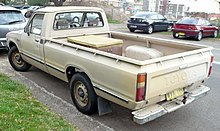
In North American markets, the Hilux (known as the pickup) saw the use of four-wheel drive. It had a solid front axle and leaf suspension. The body saw a redesign that included single round headlights and a less complex body. This new 4WD setup featured a gear driven RF1A transfer case. This transfer case is unique in that its low-range reduction portion can be replicated, using what some refer to as a dual or triple transfer case. This results in a much lower overall gear ratio.[16] It was the first Hilux available with an automatic transmission in that market.
In 1981, a vehicle development agreement was established between Toyota, Winnebago Industries and two other aftermarket customisers. This was to allow Toyota to enter the SUV market in North America. The vehicles which resulted from this collaboration were the Trekker (Winnebago), Wolverine, and the Trailblazer (Griffith). All three used the Hilux 4×4 RV cab and chassis, and an all-fiberglass rear section (the Trailblazer had a steel bed with a fiberglass top). Research and development work on the Trekker led to the development of the 4Runner/Hilux Surf, which was introduced in 1984.
Toward the end of the SR5's production run (1983½ model year), Toyota introduced the luxury Mojave trim for the US market as a limited-production (3,500 units) model with options not available on any other Toyota pickup.[17] With a list price of US$8,308 (equivalent to $21,587 in 2020),[17] it had bucket seats, two-speaker multiplex radio, chrome front and rear bumpers, and deleted Toyota logos on either the grille or the tailgate.[17] Cruise control, power steering, and air conditioning were optional.[17] It was powered by the SR5's standard 2.4 L (150 cu in) inline-four engine.[17]
In Thailand, this model was sold as the Toyota Hilux Super Star.
Engines[]
- 1978–1983: 1.6 L (1,587 cc) 12R SOHC I4, 80 PS (59 kW) at 5,200 rpm and 12.5 kg⋅m (123 N⋅m) of torque at 3,000 rpm (RN30/40, Japan)[12] 51 kW (69 PS; 68 hp) at 5,200 rpm[13]
- 1981–1983: 1.8 L preflow, 4-speed manual (Australia)[citation needed]
- 1978–1983: 2.0 L (1,968 cc) 18R SOHC I4, 89 PS (65 kW) at 5,000 rpm and 14.8 kg⋅m (145 N⋅m) of torque at 3,600 rpm (1983 European specifications)[18]
- 1978–1980: 2.2 L (2,189 cc) 20R SOHC I4, 67 kW (91 PS; 90 hp) at 4,800 rpm and 165 N⋅m (122 lb⋅ft) of torque at 2,400 rpm
- 1981–1983: 2.4 L (2,366 cc) 22R SOHC I4, 98 PS; 97 hp (72 kW) at 4,800 rpm and 175 N⋅m (129 lb⋅ft) of torque at 2,800 rpm
- 1979–1983: 2.2 L diesel I4, 46 kW (63 PS; 62 hp) at 4,200 rpm and 126 N⋅m (93 lb⋅ft) of torque (SR5 long bed only in the US), LN30/40
Fourth generation (N50, N60, N70; 1983)[]
| Fourth generation (N50, N60, N70) | |
|---|---|
 | |
| Overview | |
| Also called |
|
| Production |
|
| Model years | 1984–1988 |
| Assembly |
|
| Designer | Hiroshi Osawa[3] |
| Body and chassis | |
| Body style |
|
| Layout | |
| Related |
|
| Powertrain | |
| Engine |
|
| Transmission |
|
| Dimensions | |
| Wheelbase |
|
| Length |
|
| Width |
|
| Height |
|
| Curb weight | 1,270 kg (2,800 lb) |

The August 1983 redesign (sold as model year 1984 vehicles in North America) introduced the Xtracab extended cab option, with six inches of space behind the seat for in-cab storage. These models carried over the carbureted 22R engine while model year 1984 also saw the introduction of the fuel injected 22R-E engine. Two diesel engines were also offered, the 2L and the turbocharged 2L-T. The engines were discontinued in the U.S. after the 1986 model year, this was due to higher performance expectations from customers and the wide availability of inexpensive petrol. The next year saw the introduction of a turbocharged option, the 22R-TE, perhaps due to increasing competition from Nissan who already offered a V6 truck at this time. The solid front axle was replaced with an independent front suspension/torsion bar setup in the 4×4 model in 1986, and optional automatic differential disconnect for the front differential (an alternative to automatic locking hubs). 1985 was the last year of the solid front axle in most markets. The solid front axle would remain in the 5th generation 4x4 LN106 model until 1997. Solid front axles had been present in all 4x4 Toyota models until 1986.
In late 1986 for the 1987 model year, the truck went through a minor interior and exterior redesign, that included a new grille, a new 1 piece front bumper, an updated interior with full high door panels with faux leather stitching on the base and DLX models, the gauge cluster surround was more rounded and featured faux leather stitching on it, the dash pad featured a shorter tray than earlier models, the steering wheels were changed from black to gray, red, brown, or blue depending on the interior color, the radio bezel was also color matched to the rest of the interior, the SR-5 tach gauge clusters had the pattern on the face changed from a grid pattern to horizontal lines, the outside door mirrors were also changed to have a more stream lined appearance, the faceplate for the heater controls was also redesigned. A V6 engine was introduced in 1988. The Hilux-based 4Runner which made its entry in Australia, North America and the United Kingdom was based on this generation of the Hilux; in some other markets, such as Japan, it was called the Hilux Surf.
Toyota introduced a new generation of the Hilux in most markets in late 1988 but the fourth generation remained in production until 1997 in South Africa. The company quoted that this was due to South African "content laws" which made it cheaper to continue the production of the fourth generation of the Hilux, rather than to retool the plant for the fifth generation model.[19]
In Thailand, this generation was sold as the Toyota Hilux Hero.
Engines[]
| Calendar years | capacity | code | features | power | torque | comments |
|---|---|---|---|---|---|---|
| 1983–1984 | 2,366 cc | 22R | SOHC I4 | 72 kW (98 PS; 97 hp) at 4,800 rpm | 174 N⋅m (128 lb⋅ft) at 2,800 rpm | |
| 1983–1985 | 2,188 cc | L | I4 Diesel | 46 kW (63 PS; 62 hp) at 4,200 rpm | 126 N⋅m (93 lb⋅ft) at 2,200 rpm | (SR5 long bed only) |
| 1983–1988 | 2,446 cc | 2L | I4 Diesel | 62 kW (84 PS; 83 hp) at 4,200 rpm | 165 N⋅m (122 lb⋅ft) at 2,200 rpm | |
| 1984–1987 | 2,366 cc | 22R | SOHC I4 (2nd gen 22R engine) | 81 kW (110 PS; 109 hp) at 5,000 rpm | 187 N⋅m (138 lb⋅ft) at 3,400 rpm | revised engine design for 1985 MY |
| 1986–1988 | 2,446 cc | 2L-T | turbocharged fuel injected I4 Diesel | 69 kW (94 PS; 93 hp) at 4,000 rpm | 216 N⋅m (159 lb⋅ft) at 2,400 rpm | |
| 1983–1988 | 2,366 cc | 22R-E | SOHC fuel injected I4 | 78 kW (106 PS; 105 hp) at 4,800 rpm | 185 N⋅m (136 lb⋅ft) at 2,800 rpm | |
| 1985–1986 | 2,366 cc | 22R-TE | SOHC turbocharged fuel injected I4 | 101 kW (137 PS; 135 hp) at 4,800 rpm | 234 N⋅m (173 lb⋅ft) at 2,800 rpm | |
| 1987– | 2,958 cc | 3VZ-E | fuel injected V6 | 112 kW (152 PS; 150 hp) at 4,800 rpm | 244 N⋅m (180 lb⋅ft) at 2,400 rpm | |
| 1983– | 1,626 cc | 1Y | I4 | |||
| 1983– | 1,998 cc | 3Y | I4 | |||
| 1985– | 2,237 cc | 4Y | OHV I4 | 70 kW (95 PS; 94 hp) at 4,400 rpm | 182 N⋅m (134 lb⋅ft) at 3,000 rpm |
Fifth generation (N80, N90, N100, N110; 1988)[]
| Fifth generation (N80, N90, N100, N110) | |
|---|---|
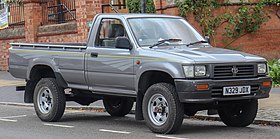 1994–1997 Toyota HiLux 4X4 Diesel | |
| Overview | |
| Also called |
|
| Production | August 1988–1997 |
| Assembly | |
| Designer | Shigeo Asai[20] |
| Body and chassis | |
| Body style |
|
| Layout | |
| Related |
|
| Powertrain | |
| Engine |
|
| Transmission |
|
| Dimensions | |
| Wheelbase |
|
| Length |
|
| Width | 1,689 mm (66.5 in) |
| Height |
|
The next redesign, in 1988, introduced a longer-wheelbase option, 3,099 mm (122 in) rather than 2,616 mm (103 in) for the regular wheelbase. Its one-piece cargo-box walls eliminated the rust-prone seams that were found in earlier models. The V6 Xtracab SR5 earned Motor Trend magazine's Truck of the Year award that year. The Xtra Cabs now featured more room behind the front seats than the last generation which allowed optional jump-seats for rear passengers, a feature more in line with competitors of the time.
In 1991, North American production began at the NUMMI plant in Fremont, California. The Hilux received a minor facelift in 1991 (for the 1992 model year), which was a grille change incorporating the new Toyota emblem that had been recently adopted.
It was during this generation that Toyota discontinued the Hilux in the United States, replacing it with the new Tacoma for the 1995 model year.[21]
Engines[]
- 1988–1995: 1.8 L (1,812 cc) 2Y-U I4, 58 kW (79 PS; 78 hp) at 5,000rpm 140 N⋅m (100 lb⋅ft) at 3,200rpm
- 1988–1995: 1.8 L (1,812 cc) 2Y I4, 61 kW (83 PS; 82 hp) at 4,800rpm 140 N⋅m (100 lb⋅ft) at 2,800rpm (export markets)[22]
- 1989–1997: 2.4 L (2,366 cc) 22R SOHC I4, 81 kW (110 PS; 109 hp) at 5,000 rpm and 187 N⋅m (138 lb⋅ft) at 3,400 rpm
- 1989–1997: 2.4 L (2,366 cc) 22R-E SOHC EFI I4, 84 kW (114 PS; 113 hp) at 4,600 rpm and 192 N⋅m (142 lb⋅ft) at 3,400 rpm
- 1989–1995: 3.0 L (2,958 cc) 3VZ-E V6, 112 kW (152 PS; 150 hp) at 4,800 rpm
- 1989–1997: 2.4 L (2,446 cc) 2L-II diesel I4, 66 kW (90 PS; 89 hp) at 4,200 rpm and 167 N⋅m (123 lb⋅ft) at 2,400 rpm[23]
- 2.8 L (2,779 cc) 3L diesel I4, 67 kW (91 PS; 90 hp) at 4,000 rpm and 188 N⋅m (139 lb⋅ft) at 2,400 rpm
Volkswagen built and marketed the Hilux under the Volkswagen Taro name from February 1989 to March 1997.
This generation of the Hilux was sold in Thailand as the Toyota Hilux Mighty-X.
Sales in South America[]
- Colombia, Ecuador and Venezuela: the Hilux was produced in Colombia from 1994 to 1997 by the Sofasa company equipped with the 22R-E 2.4 L petrol engine. For these markets the model number for the 4WD double cabin was RN106 -instead of the standard number LN106-.
- For sales in Argentina, Brazil, and Uruguay, the Hilux was produced in Argentina from 1997 through 2005 (Zárate Plant – both petrol and diesel engines).
- For sales in Bolivia, Chile, Paraguay and Peru, the Hilux was imported from factories in Japan from 1989 to 1997 (petrol and diesel engines).
The available options for these markets were:
- single cab chassis (2WD, 4WD petrol engines) (Colombia and Ecuador)
- single cab long bed (2WD,4WD, petrol and diesel engines - all South American markets; diesel engine not available in Colombia, Ecuador, and Venezuela)
- Xtracab (2WD, 4WD, petrol - only Bolivia)
- crew cab (2WD,4WD, petrol and diesel engines - all South American markets; Diesel engine not available in Colombia, Ecuador, and Venezuela)
North America[]
In North America the Hilux continued to be sold simply as the "Toyota Pickup". A wide range of models were available (excluding the Crew Cab model available internationally), mixing four- and six-cylinder engines, long and short beds, regular and Xtracabs, manual and automatic transmissions, and two- or four-wheel drive.[24] The cargo capacity was typically 1,640 lb (744 kg) for two-wheel drives and 1,400 lb (635 kg) for four-wheel drive models. GVWRs ranged from 2,565 to 5,350 lb (1,163 to 2,427 kg).[24] Initially only imported from Japan, NUMMI-built trucks began appearing in 1990. The VIN on these trucks starts with '4T', while Japanese-made ones begin with 'JT'. However, some trucks sold in the United States during the 1991 through 1995 model years were still manufactured in Japan as not all versions were built in California.
While the fifth generation Hilux continued to be sold elsewhere in the world until 1997, in North America it was replaced by the new Tacoma after an abbreviated 1995 model year.[21]
Gallery[]

1991–1997 Toyota HiLux V6 Xtra Cab

1991–1997 Toyota HiLux DX 4-door

1994-1997 Toyota HiLux 4X4 Diesel
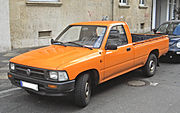
Volkswagen Taro

Toyota Hilux RN106 1998 Sofasa plate with VIN information
Sixth generation (N140, N150, N160, N170; 1997)[]
| Sixth generation (N140, N150, N160, N170) | |
|---|---|
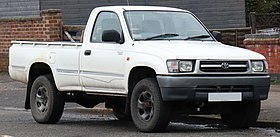 1998 Toyota HiLux 4WD | |
| Overview | |
| Production | 1997–2005 |
| Assembly |
|
| Designer | Masaaki Ishiko[26] |
| Body and chassis | |
| Body style |
|
| Layout | |
| Related |
|
| Powertrain | |
| Engine |
|
| Transmission |
|
| Dimensions | |
| Wheelbase |
|
| Length |
|
| Width |
|
| Height |
|
| Chronology | |
| Successor | Toyota Fortuner (for Hilux Sport Rider) |
The Hilux received a minor design update for the 1999 model year and the addition of a few more engine options. The Hilux was then facelifted in 2001 for the 2002 model year.
In 2005, Toyota ceased production of the Hilux truck for the Japanese market. This was the last generation of the Hilux to be built in Japan.[citation needed]
Engines[]
- 1998–2001 2.0 L (1,998 cc) 1RZ-E 8 Valve SOHC I4 (Hilux 'Workmate' models in Australia) (4×2)
- 1998–1999 3.0 L (2,986 cc) 5L diesel I4, 72 kW (98 PS; 97 hp) (4×2, 4×4)
- 1995–2004 2.4 L (2,438 cc) 2RZ-FE 16-valve DOHC I4, 106 kW (144 PS; 142 hp) (4×2, 4×4)
- 1995–2004 2.7 L (2,693 cc) 3RZ-FE 16-valve DOHC I4, 112 kW (152 PS; 150 hp) (4×2, 4×4)[27]
- 1995–2004 3.4 L (3,378 cc) 5VZ-FE 24-valve DOHC V6, 142 kW (193 PS; 190 hp)
- 1998-2001 2.4 L (2,446 cc) 2L-T UK Spec - Turbo Diesel single valve 8-valve I4 83/62 hp/kW at 4,000 rpm, 16.8/165 kg⋅m/N⋅m at 2,200 rpm (4x4)
- 1998-2004 2.8 L (2,779 cc) 3L diesel I4, 65 kW (89 PS; 88 hp) (4x4) (Philippines, Malaysia, SAE Net, UN Spec)
- South American markets
The Hilux was produced in Colombia for sales in Colombia, Venezuela, and Ecuador from 1998 to 2005 by the SOFASA company (with only petrol engines 2.7 L). In Venezuela and Ecuador, the single-cab 2WD chassis/long bed is called the Stout II. For sales in Bolivia, Chile, Paraguay, Peru, it was imported from Japan from 1998 through 2004 (petrol engined 2.7 L, and diesel engined 2.8 L). This model was not sold in Argentina or Brazil because the fifth-generation Hilux had received a redesign and upgrade. Options for South American markets included:
- Single cab chassis (2WD, 4WD petrol engines) (for sales in Colombia and Ecuador)
- Single cab long bed (2WD,4WD, petrol and diesel engines) (all South American countries)
- Xtracab (4WD, petrol and diesel engines) (in Bolivia only)
- Crew cab (2WD,4WD, petrol and diesel engines) (all South American countries, named the Hilux Millenium from 2002 through to the present)
- Thailand market
Toyota shifted production from the Hilux Mighty-X (fifth generation) to the Hilux Tiger (sixth generation) in the late 1990s and made it the global export hub. The Thailand-made Hilux Tiger went through the following versions:
- 1998–1999: Hilux Tiger with the 3.0 L 5L engine
- 2000–2001: Hilux Tiger with the 3.0 L 5L-E EFI engine
- 2001: Hilux Tiger with 1KZ engine (short-lived and immediately replaced by D4D engine)
- Late 2001 – late 2004: Hilux Tiger SportCruiser with D4D engine[28]
Gallery
Pickup 4WD Wide Extra cab Sports 2.7 L (RZN174H)
Pickup 4WD Wide Extra cab Sports 2.7 L (RZN174H)

1997–2001 Toyota Hilux 2-door utility (RZN149R)
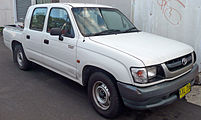
2001–2004 (RZN149R) 4-door utility
Post-facelift Pickup 4WD Wide Double cab Sports 2.7 (RZN169H)

2003-2004 Pickup Extra cab 3.0 G Limited (KDN151)
Sport Rider[]
This section does not cite any sources. (March 2020) |
Toyota introduced a mid-size SUV variant of the Hilux in 1998. The variant called the Sport Rider was sold only in Thailand. The Sport Rider is based on the Hilux, both in style and underpinnings it is similar in concept to the Toyota 4Runner—however, it's not a rebadged 4Runner. The Sport Rider frame and suspension system are derived from the Hilux, including the Hilux's independent front suspension and leaf-sprung rear suspension. The vehicles began as four-door pickup trucks and were then modified into wagons on arrival in Thailand by Thai Auto Works Co (a majority Thai-owned company in which Toyota has a 20 percent stake). The vehicles were distributed by Toyota Tsusho Thailand, the importer of Toyota forklifts.
Engine options for the Sport Rider included the 5L engine for the Prerunner (2WD), the 5L, and the 5L-E engine for 4WD. Toyota introduced the first facelift in 2001 with the 1KZ-TE engine and foglamps integrated with the front bumper, Toyota introduced the second facelift in 2002 with the 1KD-FTV engine for 4WD and the 2KD-FTV engine for the Prerunner (2WD) and 4WD, a new front bumper, new projector-style headlights, and new rear lamps. Toyota discontinued the Sport Rider in 2004 and replaced it with the Toyota Fortuner in 2005.
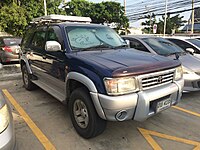
Toyota Sport Rider

Rear view
Engines[]
- 1998–2002: 3.0 L (2,986 cc) 5L-E I4 SOHC EFI, 77 kW (105 PS; 103 hp) at 4,000 rpm 200 N⋅m (150 lb⋅ft) at 2,600 rpm
- 1998–2002: 3.0 L (2,986 cc) 5L I4, 72 kW (98 PS; 97 hp) at 4,000 rpm 192 N⋅m (142 lb⋅ft) at 2,400 rpm (Prerunner)
- 2001–2002: 3.0 L (2,982 cc) 1KZ-TE I4 SOHC, 92 kW (125 PS; 123 hp) at 3,600 rpm and 315 N⋅m (232 lb⋅ft) at 2,000 rpm
- 2002–2004: 3.0 L (2,982 cc) 1KD-FTV I4 DOHC, 93 kW (126 PS; 125 hp) at 4,800 rpm and 315 N⋅m (232 lb⋅ft) at 1,800–2,600 rpm
- 2002–2004: 2.5 L (2,494 cc) 2KD-FTV I4 DOHC, 75 kW (102 PS; 101 hp) at 3,600 rpm and 260 N⋅m (190 lb⋅ft) at 1,400–3,400 rpm
Seventh generation (AN10, AN20, AN30; 2004)[]
| Seventh generation (AN10/AN20/AN30) | |
|---|---|
 Toyota Hilux (KUN26R) 4-door | |
| Overview | |
| Also called | TruckMasters OX (Finland) |
| Production | August 2004[29] – May 2015 |
| Assembly | |
| Designer | Kaoru Hosokawa (2002)[38] |
| Body and chassis | |
| Body style |
|
| Layout | |
| Platform | Toyota IMV |
| Related |
|
| Powertrain | |
| Engine |
|
| Transmission |
|
| Dimensions | |
| Wheelbase |
|
| Length |
|
| Width |
|
| Height |
|

The seventh generation of the Hilux (designated the AN10/AN20/AN30), part of the IMV program, started production in Thailand during August 2004.[29] Three pickup truck body variants were initially produced: a two-door Single Cab (referred to by Toyota as IMV1), a two-door Xtra Cab (IMV2), and four-door Double Cab (IMV3).[39] In September 2008, Toyota introduced the Smart Cab, a four-door cab with hidden rear clamshell doors.[40] The IMV program also spawned the Toyota Innova (AN40) minivan (IMV4) and Toyota Fortuner (AN50/AN60) SUV (IMV5).[29] The similar Toyota Tacoma pickup truck, introduced in February 2004 for the 2005 model year, is based on the 4Runner chassis, while the AN10/AN20/AN30 Hilux is based on an revamped version of the ladder frame found on previous versions. The Hilux increased in size and began to be classified as a mid-size pickup truck.
Hilux models sold in Asian, European, Middle Eastern and Oceanian markets were initially built and assembled in Thailand. Later, production was delegated to Malaysia and Southeast Asia in order to increase sales in those regions.[29] In Thailand, the vehicle is called the Hilux Vigo, or simply Vigo.[39] For other European markets and South Africa, the Hilux was built in Durban, South Africa.[29] Hiluxes sold in Argentina and Brazil were built in Argentina, as with the previous generation Hilux.[41]
The double cab model has an automatic transmission. It uses the same engine as other Asian countries (in-line, 4-cylinder, 16-valve, DOHC Turbo Diesel with common rail direct injection), however engines used in Malaysia differ in their maximum output of 75 kW (102 PS; 101 hp) at 3,600 rpm and maximum torque of 260 N⋅m (192 lb⋅ft) at 1,600–2,400 rpm.
In Singapore, the Hilux was available as a single cab with the 2.5 L engine or a double cab with the 3.0 L engine.
Notable fleet customers include private taxi operators, for whom the double cab model offers additional load space versatility, the Singapore Police Force, Pakistan Police Force, Syrian Police Force and the Royal Bhutan Police Force; all of which employ the Hilux as a patrol vehicle.
This generation of the Hilux was introduced for Argentina on 2 March 2005 in Buenos Aires with a market launch in April.[42]
This generation of the Hilux was also sold in Finland as the TruckMasters OX by Truck Masters Finland. Because of a modified rear suspension, the truck is registered in Finland as a light truck. The OX was only available with a 3.0-litre D-4D diesel engine.[43]

Pre-facelift (front)

Pre-facelift (rear)
Engines[]
- 2005 2.0 L petrol VVT-i DOHC I4 (South Africa, Indonesia and Middle East)
- 2005 2.5 L diesel D-4D DOHC I4, Turbodiesel 76 kW (103 PS; 102 hp) – 107 kW (145 PS; 143 hp) (Asia, Europe, South Africa, South America)
- 2005 2.7 L petrol VVT-i DOHC I4, 119 kW (162 PS; 160 hp) (Australia, Arabian Peninsula, Philippines, South Africa, Venezuela)
- 2005 3.0 L diesel D-4D DOHC I4, Turbodiesel, commonrail 16-valve direct injection, 121 kW (165 PS; 162 hp) (Asia, South Africa, South America, Australia, Europe). This version is made at Toyota's facility in Zárate, Argentina.
- 2005 4.0 L petrol VVT-i DOHC V6, 170 kW (231 PS; 228 hp) – 176 kW (236 hp) (Australia, South Africa, Venezuela, China)
- 2008 4.0 L Supercharged DOHC V6 225 kW (306 PS; 302 hp) (Australia only, TRD Hilux 4000S & 4000SL)[44]
2008 facelift[]
A facelifted version of the Hilux was unveiled by Toyota's Malaysian distributors, UMW Toyota Motor, in August 2008. Toyota has introduced a left hand drive Hilux Vigo in August 2008 while a right hand drive facelifted model was introduced in September 2008. These facelifted models were introduced in the Philippines in October 2008.
Toyota also introduced a four-door extended cab called "Smart Cab" to replace all Xtra Cab models in E and G grade. The Smart Cab models were developed in Thailand and were only sold in the Thai market.[40]
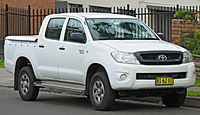
2008 facelift (front)

2008 facelift (rear)
2011 facelift[]
On 13 July 2011, Toyota announced that the Hilux would receive a facelift, including a redesigned front end and other external styling changes, changes to the interior and a new turbocharged diesel engine rated at 107 kW (144 hp) and 343 N⋅m (253 lb⋅ft) of torque, as well as lower fuel consumption compared to the previous model.[45] This update was initially launched in Thailand.[46]

2011 facelift (front)

2011 facelift (rear)
2012 Hilux Vigo Champ[]
The Hilux Vigo "Champ" was introduced in Thailand in August 2012 as a significant "minor change" with a new front design and a revamped interior to reinforce perceived luxury. The front was redesigned from the A pillar forwards. With the exception of the doors, roof and tailgate, everything else was new: new guards, new headlights, new bumper, new bonnet, new three-bar grille, new taillights, a new rear bumper and new badges. There were also new mirrors and new alloy wheel designs. The interior features a new upper dashboard design with a new horizontal center instrument cluster. Perceived quality was improved through the adoption of uniformly darker finishes with greater color consistency throughout the interior. The high-end Double Cab version now came with a DVD player, rear camera and Bluetooth functionality.[47]
This minor update upgraded the emission standard to Euro 4, updated the four-speed automatic transmission to five-speed, upgraded power rating of the 3.0-liter model from 122 to 128 kW (166 to 174 PS; 164 to 172 hp), increased torque from 343 to 360 N⋅m (253 to 266 ft⋅lb) for the five-speed automatic transmission, and the Smart Cab Prerunner 4x2 was introduced with automatic transmission. Other changes included a more efficient fuel injection system and the addition of a center headrest on the rear double cab seat.
Eighth generation (AN120, AN130; 2015)[]
| Eighth generation (AN120/AN130) | |
|---|---|
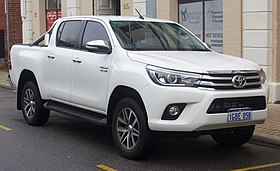 2016 Toyota Hilux SR5 | |
| Overview | |
| Also called | TruckMasters OX (Finland) |
| Production | 2015–present |
| Assembly |
|
| Designer | |
| Body and chassis | |
| Body style |
|
| Layout | |
| Platform | Toyota IMV |
| Related |
|
| Powertrain | |
| Engine | |
| Transmission | |
| Dimensions | |
| Wheelbase | 3,085 mm (121.5 in) |
| Length |
|
| Width | 1,800–1,855 mm (70.9–73.0 in) |
| Height |
|
| Curb weight | 1,955–2,100 kg (4,310–4,630 lb) |


The eighth generation of the Toyota Hilux was officially introduced simultaneously on 21 May 2015 in Bangkok, Thailand and Sydney, Australia. However, the pickup truck was available for sale in the showrooms from October, 5 months after its official introduction.[55]
Some Southeast Asian market (Thailand, Laos, Cambodia) also adopted a new name, "Toyota Hilux Revo". The Hilux uses the "Keen Look" design language that has already been used on the Toyota Corolla (E170) with slim projector headlights and LED DRL (Daytime Running Lights). This design continues into the interior with similar AC vents and center fascia design. This generation has Toyota's first autonomous emergency braking (AEB).[56]
New ESTEC GD 2.4-litre, 2.8-litre and KD 2.5-litre along with 3.0-litre diesel engines, shared with the Fortuner and Innova, were combined with a 5 or 6-speed manual transmission or a 5 or 6-speed automatic transmission with sequential shift technology respectively.[57] The 2.8-liter GD engine was introduced in May 2015 at the 36th International Vienna Motor Symposium.[58] The 2.0-litre, 2.7-litre and 4.0-litre petrol engines from the previous generation returned with a Dual VVT-i update for increased power and torque.[59][60]
Like the previous generation, this generation has also been sold as the TruckMasters OX in Finland by Truck Masters Finland since 2017. The modified suspension means that the truck is registered as a light truck in Finland, leading to lower taxes.[61]
The Hilux was reintroduced in Japan on 12 September 2017, after 13 years of hiatus. As a mid-size pickup truck, the Hilux exceeds the Japanese governing regulations for the vehicle size dimensions, thus Japanese buyers are liable to higher taxes compared to passenger cars. Nevertheless, the initial orders for the vehicle exceeded 2,000 in the first month of sales.[62] For the Japanese market, the Hilux is imported from Thailand, with only double-cab 4WD configuration available in two trim levels "X" and "Z", both equipped with 2.4-litre 2GD-FTV engine and a 6-speed automatic transmission.
Hilux Revo Rocco[]
The Hilux Revo Rocco was unveiled at the 34th Thailand International Motor Expo on 30 November 2017. It features a different front grille styling similar to the North American market Tacoma and a different front bumper with LED fog lights. The Thai market Rocco has a grey rear bumper bar, 18-inch alloy wheels with all-terrain tyres, a black sports bar with bed liner, Rocco insignia, gloss black grille, black metallic trim on the interior along with a redesigned instrument cluster. The engine and safety features for the Rocco remain unchanged.
The Rocco was introduced in Malaysia as Hilux L-Edition in 2018. In the Philippines, the Rocco was introduced in February 2018 as the Conquest.[63] In the UK, this model is only available for the 'Invincible X' variant,[64] which was launched at the Commercial Vehicle Show on 24 April 2018.[65] In Japan, this model was sold as the Z "Black Rally Edition", which was announced on 12 November 2018 and released on 17 December 2018 to commemorate the 50th anniversary since the launch of the first generation Hilux.[66]

2018 Hilux SR5 4WD (GUN126R)
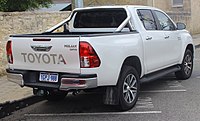
2018 Hilux SR5 4WD (GUN126R)
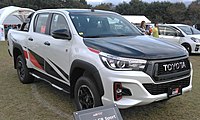
Hilux GR Sport (pre-facelift)
2020 facelift[]
In June 2020, Toyota unveiled the facelift of the AN120/130 series Hilux for select Asian and European markets. The facelift model received revised front and rear with LED headlamps and tail-lamps and front LED indicators, a first for the Hilux, and redesigned 18-inch alloy wheels. For some Southeast Asian market, the Hilux is equipped with Toyota Safety Sense. This facelift of the Hilux was introduced in Japan in August 2020 and is currently offered in base X and Z trim levels. The power and torque figures for 2.8-litre 1GD-FTV engine has been upgraded to 204 PS (150 kW; 201 hp) and 500 N⋅m (369 lbf⋅ft) (in automatic transmission).[67]
The facelift model GR Sport version was released in Thailand on 25 August 2021,[68][69] in Japan on 8 October 2021[70] and in the Philippines on 23 October 2021.[71]

Hilux Invincible D-4D (United Kingdom)
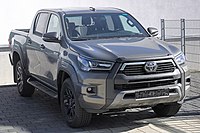
2021 Hilux Invincible X/Rogue/Rocco/Adventure/Conquest
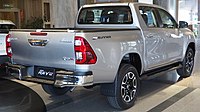
Hilux Revo Double Cab Prerunner 2.4 Mid (GUN122)

Hilux Revo Double Cab 4x2 2.8 GR Sport (GUN136)

Hilux Revo Double Cab 4x4 2.8 GR Sport (GUN126)
| Model | Engine | Transmission | Power | Torque |
|---|---|---|---|---|
| 2.0 | 2.0 L 1TR-FE inline-4 fuel-injected petrol with Dual VVT-i | 6-speed manual | 104 kW (139 hp) at 5,500 rpm | 185 N⋅m (136 lb⋅ft) at 3,800 rpm |
| 6-speed AC60E/AC60F automatic | ||||
| 2.4 | 2.4 L 2GD-FTV inline-4 common rail diesel with VNT | 5-speed R151 manual | 110 kW (150 hp) at 3,400 rpm | 343 N⋅m (253 lb⋅ft) at 1,400–2,800 rpm |
| 6-speed RC60/RC60F manual | 400 N⋅m (300 lb⋅ft) at 1,600–2,000 rpm | |||
| 6-speed AC60E/AC60F automatic | ||||
| 2.5 | 2.5 L 2KD-FTV inline-4 common rail diesel without intercooler | 5-speed R151 manual | 76 kW (102 hp) at 3,600 rpm | 200 N⋅m (150 lb⋅ft) at 1,600–3,600 rpm |
| 6-speed RC61 manual | 260 N⋅m (190 lb⋅ft) at 1,600–2,400 rpm | |||
| 2.5 | 2.5 L 2KD-FTV inline-4 common rail diesel with VNT | 6-speed manual | 107 kW (144 hp) at 3,400 rpm | 343 N⋅m (253 lb⋅ft) at 1,800–3,400 rpm |
| 5-speed A750F automatic | ||||
| 2.7 | 2.7 L 2TR-FE inline-4 fuel-injected petrol with Dual VVT-i | 6-speed manual | 120 kW (160 hp) at 5,500 rpm | 246 N⋅m (181 lb⋅ft) at 3,800 rpm |
| 6-speed AC60E/AC60F automatic | ||||
| 2.8 | 2.8 L 1GD-FTV inline-4 common rail diesel with VNT | 5-speed R151 manual | 130 kW (170 hp) | 343 N⋅m (253 lb⋅ft) at 1,200–3,400 rpm |
| 6-speed RC61 manual / RC61F iMT (Intelligent Manual Transmission) manual (Thailand) | 132 kW (177 hp) at 3,400 rpm
(2nd facelift): 150 kW (201 hp) at 3,400 rpm |
420 N⋅m (310 lb⋅ft) at 1,400–2,600 rpm
(2nd facelift): 420 N⋅m (310 lb⋅ft) at 1,400–3,400 rpm | ||
| 6-speed AC60E/AC60F automatic | 450 N⋅m (330 lb⋅ft) at 1,600–2,400 rpm
(2nd facelift): 500 N⋅m (370 lb⋅ft) at 1,600–2,800 rpm | |||
| 3.0 | 3.0 L 5L-E inline-4
naturally aspirated diesel |
5-speed manual | 71 kW (95 hp) at 4,000 rpm | 197 N⋅m (145 lb⋅ft) at 2,200 rpm |
| 3.0 | 3.0 L 1KD-FTV inline-4
common rail diesel with VNT |
6-speed RC61 manual | 122 kW (163 hp) at 3,400 rpm | 343 N⋅m (253 lb⋅ft) at 1,600–3,400 rpm |
| 5-speed A750F automatic | 360 N⋅m (270 lb⋅ft) at 1,800–3,400 rpm | |||
| 4.0 | 4.0 L 1GR-FE V6 fuel-injected petrol with VVT-i | 6-speed RC61 manual | 175 kW (235 hp) at 5,200 rpm | 376 N⋅m (277 lb⋅ft) at 3,700 rpm |
| 6-speed AC60E/AC60F automatic |
Production[]
| Year | Worldwide production[72] |
|---|---|
| 1968 | 33,708 |
| 1969 | 48,041 |
| 1970 | 69,787 |
| 1971 | 77,865 |
| 1972 | 79,523 |
| 1973 | 75,541 |
| 1974 | 78,727 |
| 1975 | 115,466 |
| 1976 | 137,101 |
| 1977 | 215,696 |
| 1978 | 224,113 |
| 1979 | 237,309 |
| 1980 | 306,063 |
| 1981 | 302,580 |
| 1982 | 333,103 |
| 1983 | 345,117 |
| 1984 | 432,871 |
| 1985 | 461,253 |
| 1986 | 440,905 |
| 1987 | 383,688 |
| 1988 | 394,468 |
| 1989 | 374,387 |
| 1990 | 362,147 |
| 1991 | 344,501 |
| 1992 | 387,279 |
| 1993 | 405,752 |
| 1994 | 425,999 |
| 1995 | 384,571 |
| 1996 | 387,571 |
| 1997 | 351,417 |
| 1998 | 353,340 |
| 1999 | 358,793 |
| 2000 | 343,646 |
| 2001 | 363,354 |
| 2002 | 396,013 |
| 2003 | 276,172 |
| 2004 | 323,625 |
| 2005 | 370,191 |
| 2006 | 428,616 |
| 2007 | 508,132 |
| 2008 | 491,702 |
| 2009 | 438,812 |
| 2010 | 548,889 |
| 2011 | 518,274 |
| 2012 | 745,303 |
| 2013 | 732,661 |
| 2014 | 648,930 |
| 2015 | 597,899 |
| 2016 | 537,474 |
| 2017 | 520,742 |
Sales[]
| Calendar Year | Thailand | Australia | New Zealand | Philippines | South Africa | Brazil | Mexico[73] |
|---|---|---|---|---|---|---|---|
| 2006 | 166,358[74] | 36,885[75] | |||||
| 2007 | 158,348[74] | 42,009[75] | |||||
| 2008 | 127,028[74] | 42,956[76] | 21,731[77] | ||||
| 2009 | 102,026[74] | 38,457[78] | 30,994[79] | ||||
| 2010 | 144,190[74] | 39,896[80] | 33,656[81] | ||||
| 2011 | 121,887[74] | 36,124[82] | 33,260[83] | ||||
| 2012 | 233,293[74] | 40,646[82] | 38,889[84] | 5,499 | |||
| 2013 | 206,939[74] | 39,931[85] | 42,627[86] | 9,120 | |||
| 2014 | 144,693[87] | 38,126[88] | 43,310[89] | 8,783 | |||
| 2015 | 120,112[90] | 35,161[88] | 5,623[91] | 32,684[92] | 10,504 | ||
| 2016 | 120,444[93] | 42,104[94] | 6,187[95] | 12,405[96] | 34,031[97] | 13,644 | |
| 2017 | 109,988[98] | 47,093[94] | 8,106[99] | 14,688[100] | 36,422[101] | 34,378[102] | 19,132 |
| 2018 | 150,928[74] | 51,705[103] | 8,086[104] | 18,237[105] | 40,022[106] | 39,313[107] | 18,943 |
| 2019 | 165,452[108] | 47,759[109] | 7,126[110] | 20,846[111] | 40,934[112] | 40,408[113] | 17,654[114] |
| 2020 | 129,893[115] | 45,176[116] | 10,642[117] | 32,395[118] | 13,666 |
Reputation[]
The Hilux has often been described as having a high level of durability and reliability during sustained heavy use or even abuse.[119][120][121]
This reputation was highlighted in several episodes of the BBC motoring show Top Gear. In series 3, episodes 5 and 6, a 1988 diesel N50 Hilux with 305,775 km (190,000 mi) on the odometer was subjected to considerable abuse including being left on a beach for the incoming tide, left on top of a building as it was demolished and being set on fire.[122][123] The Hilux suffered severe structural damage, but was still running after being repaired with only the typical tools that would be found in a truck's toolbox.[124] This Hilux became one of the background decorations in the Top Gear studio. In the later series 8, episode 3, a Hilux was chosen by Jeremy Clarkson as his platform for creating an amphibious vehicle (though by the end of that episode the Hilux failed to start), and in the Top Gear: Polar Special Clarkson and James May raced a specially modified 2007 model Hilux to the magnetic north pole from Northern Canada – making the truck the first motor vehicle to make it to the magnetic north pole. The camera crew's vehicle from this episode was later modified and driven to near the summit of the Eyjafjallajökull erupting Icelandic volcano by James May in Series 15, Episode 1.
In 1999, the Hilux appeared in a series of "Bugger" television adverts in New Zealand and Australia.[125][126] The adverts were banned in New Zealand after receiving 120 complaints but later reinstated.[127]
A world record was achieved by the support crew for the participants in the 2008/2009 Amundsen Omega 3 South Pole Race. The crew traveled in specially adapted Toyota Hiluxes modified by Arctic Trucks, completing a trip of over 5,000 km (3,100 mi) from Novo, a Russian Scientific Station in Antarctica to the Geographic South Pole and back again, making them the first 4×4s to reach the South Pole.[128] The return journey of 2,500 km (1,600 mi) from the South Pole to Novo Station was completed in a record 8 days and 17 hours.
Despite being discontinued in Japan prior to 2017, the Hilux had been popularly grey-imported throughout private importers. This fact, along with the existing Hilux users' requests, encouraged Toyota to revive the Hilux in Japan after it had been discontinued 13 years earlier.
Racing[]

Two Hilux pickups entered the Dakar Rally in 2012, prepared by the Imperial Toyota team of South Africa. Driver Giniel de Villiers achieved third place in the 2012, second place overall in the 2013, 4th in the 2014, and again second place in the 2015. These however, were heavily modified non-production versions built around a custom racing-only tubular chassis and using a larger capacity Toyota V8 engine.[129] Since 2016, the Dakar Rally Hilux has been prepared by Toyota Gazoo Racing WRT. Giniel achieved third place with it in 2016, 5th in 2017, 3rd in 2018 and 9th in 2019. Nasser Al-Attiyah won the 2019 Dakar Rally, earning the first ever Toyota victory in the Dakar Rally, he also came in second in 2018 and 2021. In the 2020 Dakar Rally, six Hilux cars were entered prepared by Gazoo Racing, and another nine by Overdrive Racing. A new, wider, heavier, featuring larger wheels Toyota GR DKR Hilux T1+ was built by Gazoo Racing for 2022 Dakar Rally, equipped with 3.5l twin-turbo V6 engine, based on Toyota Land Cruiser 300 GR Sport.[130]
Use by militant groups[]
Due to its durability and reliability, the Toyota Hilux, along with the larger Toyota Land Cruiser, has become popular among militant groups in war-torn regions as a technical.[131] According to terrorism analyst Andrew Exum, the Hilux is "the vehicular equivalent of the AK-47. It's ubiquitous to insurgent warfare."[132] U.S. counter-terror officials have inquired with Toyota how the Salafi jihadist extremist group Islamic State of Iraq and the Levant has apparently acquired large numbers of Toyota Hiluxes and Land Cruisers. Mark Wallace, the CEO of the Counter Extremism Project said, "Regrettably, the Toyota Land Cruiser and Hilux have effectively become almost part of the ISIS brand."[133]
The 1980s Toyota War between Libya and Chad was so named because of the heavy, successful use of Hilux trucks for technicals.[132]
Notes and references[]
- ^ ブリスカ [Briska] (in Japanese). 日野自動車・車図鑑 [Hino Motors, Image Gallery]. 29 November 2009. Archived from the original on 20 May 2013. Retrieved 22 May 2012.
- ^ Hasham, Nicole (10 April 2019). "Toyota scuppers claim Labor's electric vehicle policy would leave HiLux drivers stranded". The Canberra Times. Archived from the original on 10 April 2019. Retrieved 10 April 2019.
- ^ a b c d "1st to 4th generation Hilux Chief Engineers | Hilux 50th Anniversary Special Website" (Press release). Toyota. 21 May 2018. Archived from the original on 28 January 2019. Retrieved 28 January 2019.
- ^ a b c d "Toyota Announces Full Model Change in Hi-Lux Small Pick-up Truck Series" (Press release). Toyota. 1 September 1978. Archived from the original on 28 January 2019. Retrieved 28 January 2019.
- ^ a b c d e f g h i j "Toyota Vehicle Identification Manual". Toyota Motor Sale Co., Ltd. – Export Parts Department. 1984. 97913-84. Cite journal requires
|journal=(help) - ^ Toyota Commercial Cars (Catalog), Toyota, 1969, p. 7
- ^ a b Ruiz, Marco (1986). 'The Complete History of the Japanese Car: 1907 to the Present. Rome: ERVIN srl. p. 166. ISBN 0-517-61777-3.
- ^ a b 愛される車づくり。トヨタはあすにいどみます。 [Lovable car manufacture. Toyota dares to defy tomorrow.] (catalog) (in Japanese), Toyota Motor Co., 1972, pp. 5–6
- ^ Wright, Cedric, ed. (September 1978). "Toyota Hi-Lux 2000 Automatic". CAR. Vol. 22 no. 78. South Africa: Ramsay, Son & Parker (Pty) ltd. pp. 76–77.
- ^ "自動車ガイドブック: Japanese motor vehicles guide book" (in Japanese). 20. Japan: Japan Automobile Manufacturers Association. 30 October 1973: 227. Cite journal requires
|journal=(help) - ^ "Tahara Plant". Toyota Motor Corporation. 2012. Archived from the original on 2 August 2013. Retrieved 18 July 2014.
- ^ a b c "自動車ガイドブック [Japanese Motor Vehicles Guide Book]" (in Japanese). 25. Japan: Japan Automobile Manufacturers Association. 10 October 1978: 109. 0053-780025-3400. Cite journal requires
|journal=(help) - ^ a b Toivonen, Rauno, ed. (18 October 1979). "Lyhyesti: Hi-Lux" [In Brief: Hi-Lux]. Tekniikan Maailma (in Finnish). Vol. 35 no. 17/79. Helsinki: TM-Julkaisu. p. 142. ISSN 0355-4287.
- ^ Boyce, David, ed. (1981), What car is that? : in Australia & New Zealand, Adelaide, Australia: Rigby, p. 174, ISBN 0727014803
- ^ Boyce, p. 175
- ^ "Dual Case Setup". Marlin Crawler. Archived from the original on 28 January 2013. Retrieved 9 April 2011.
- ^ a b c d e "Pickups and Mini-Trucks". Pickups and Mini-Trucks. Hot Rod Magazine. 1 (5): 36. 1983.
- ^ Meurer, Stany (28 April 1983). "Dossier Pick-up" [The pickup file]. De AutoGids (in Dutch). Brussels, Belgium: Uitgeverij Auto-Magazine. 4 (94): 45.
- ^ McCamish, Brian. "Hilux 1984–1988". Brian894x4.com. Archived from the original on 15 February 2012. Retrieved 22 May 2012.
- ^ "Shigeo Asai, Chief Engineer for the 5th generation Hilux | Hilux 50th Anniversary Special Website" (Press release). Toyota. 25 September 2018. Archived from the original on 28 January 2019. Retrieved 28 January 2019.
- ^ a b Inama, John (24 November 2015). "Old vs. New: 1995 Toyota Tacoma vs. 2016 Toyota Tacoma". The Fast Lane Truck. Archived from the original on 5 September 2016. Retrieved 1 September 2016.
- ^ Rex, Rainer, ed. (July 1989), Lastauto Omnibus Katalog 1990 [Truck and bus catalog] (in German), 19, Motor-Presse-Verlag GmbH und Co. KG, p. 151, 81531/89001
- ^ Mastrostefano, Raffaele, ed. (1990). Quattroruote: Tutte le Auto del Mondo 1990 (in Italian). Milano: Editoriale Domus S.p.A. p. 1332.
- ^ a b Siegel, Stewart (July 1990). "The New Models for 1991: Light Trucks". Fleet Owner. Vol. 85 no. 7. FM Business Publications. p. 62.
- ^ "Cumulative Toyota Production in Pakistan Reaches 500,000 Units | Toyota Motor Corporation Official Global Website". global.toyota. Retrieved 14 February 2021.
- ^ "Masaaki Ishiko, Chief Engineer for the 6th generation Hilux | Hilux 50th Anniversary Special Website" (Press release). Toyota. 26 July 2018. Archived from the original on 28 January 2019. Retrieved 28 January 2019.
- ^ "Toyota Hilux Utility Review (Mk.6: 1997-05)". AustralianCar.Reviews. Australia. Retrieved 12 July 2020.
- ^ "Detailed Specs of Thailand-made Hilux Tiger 1998–2004". Archived from the original on 11 March 2009. Retrieved 5 September 2008.
- ^ a b c d e f g h i j k "Toyota IMV Sales Reach Global 5 Million-unit Mark" (Press release). Toyota Motor Corporation. 6 April 2012. Archived from the original on 30 October 2015. Retrieved 30 December 2015.
- ^ "Toyota rumo ao topo do mundo" [Toyota towards the top of the world] (in Portuguese). Istoé Dinheiro. 16 March 2005. Archived from the original on 30 December 2015.
- ^ "Malaysian Market: Production Volume Rises to 500,000-unit Level; Forecast to Reach 600,000 by End of Decade". MarkLines. 7 June 2005. Archived from the original on 30 December 2015.
- ^ "Kereta CKD Malaysia" [Malaysia CKD cars] (in Malay). ArenaKereta. 12 October 2013. Archived from the original on 27 August 2014.
- ^ "Company profile". Indus Motors Company. Archived from the original on 7 February 2015.
- ^ Young, Angelo (19 August 2013). "About 30,000 South Africa Auto Workers Walk Off The Job; Toyota, GM, Ford Auto Exports Affected; BMW Strike Enters Second Week". International Business Times. Archived from the original on 30 December 2015.
- ^ Pettendy, Marton (17 October 2011). "Thai floods halt Aussie ute supplies". GoAuto. Archived from the original on 4 March 2016. Retrieved 30 December 2015.
- ^ "Activities by Region, Latin America". Toyota Motor Corporation. 2012. Archived from the original on 22 December 2015. Retrieved 30 December 2015.
- ^ "Overview of Overseas Production Affiliates, Latin America". Toyota Motor Corporation. 2012. Archived from the original on 4 March 2016. Retrieved 30 December 2015.
- ^ "Kaoru Hosokawa, Chief Engineer for the 7th generation Hilux | Hilux 50th Anniversary Special Website" (Press release). Toyota. 25 May 2018. Archived from the original on 27 January 2019. Retrieved 28 January 2019.
- ^ a b "IMV Project Production Vehicles". Toyota Motor Corporation. 2012. Archived from the original on 15 November 2015. Retrieved 30 December 2015.
- ^ a b "Thailand: Planned Production Capacity in the Country Amounting to Roughly 2.6 Million a Year in 2015". MarkLines. 4 November 2008. Archived from the original on 30 December 2015.
- ^ "Toyota Argentina Unveils New Hilux Pickup" (Press Release). Toyota Motor Corporation. 2 March 2005.
- ^ "Toyota Argentina Unveils New Hilux Pickup" (Press release). Japan: Toyota Motor Corporation. 2 March 2005. Archived from the original on 2 May 2014. Retrieved 2 May 2014.
- ^ "TruckMasters OX nyt tarjous hintaan!". Archived from the original on 22 March 2017. Retrieved 21 March 2017.
- ^ The New TRD Hilux (sales brochure), Toyota Motor Corporation Australia Limited, April 2008.
- ^ "Official: Toyota Hilux pickup gets fresh skin, more power for 2012". Autoblog. 13 July 2011. Archived from the original on 16 July 2011. Retrieved 13 July 2011.
- ^ "Toyota Hilux Vigo ::: Double Cab". Archived from the original on 11 August 2011.
- ^ "New Features in 2013 Toyota Hilux Vigo Champ" (Press release). Thailand: Jim's Autos Worldwide. Archived from the original on 3 October 2017. Retrieved 4 October 2017.
- ^ "Thai-made Toyota Hilux off to Japan after 13 years". The Nation Thailand. Retrieved 14 February 2021.
- ^ "No prices increase for Toyota CKD Models". The Malaysian Reserve. 28 February 2020. Retrieved 14 February 2021.
- ^ ADEFA. "Toyota: 20 years of production in Argentina | News | Press". ADEFA. Retrieved 14 February 2021.
- ^ Venter, Irma. "Toyota SA opens R6.1bn Fortuner, Hilux assembly lines". www.engineeringnews.co.za. Retrieved 14 February 2021.
- ^ "Hiroki Nakajima, Chief Engineer for the 8th generation Hilux | Hilux 50th Anniversary Special Website" (Press release). Toyota. 21 May 2018. Archived from the original on 28 January 2019. Retrieved 28 January 2019.
- ^ "Masahiko Maeda, Chief Engineer for the 8th generation Hilux | Hilux 50th Anniversary Special Website" (Press release). Toyota. 21 March 2018. Archived from the original on 28 January 2019. Retrieved 28 January 2019.
- ^ "LAN125L-DNMXEN - Hilux LHD 3.0L Diesel 6 seater". Toyota Gibraltar Stockholdings Ltd. Archived from the original on 9 January 2018. Retrieved 8 August 2018.
- ^ Sze, Gregory (5 May 2015). "2016 Toyota Hilux pick-up slated for May 21 debut". Malaysia: PaulTan.org. Archived from the original on 9 May 2015. Retrieved 5 May 2015.
- ^ Maric, Paul (23 April 2015). "2016 Toyota HiLux engine details leaked, ute to debut autonomous emergency braking". Car Advice. Australia. Archived from the original on 26 April 2015. Retrieved 29 April 2015.
- ^ "2016 Toyota HiLux Revo Thailand". Thailand. 1 May 2015. Archived from the original on 18 May 2015. Retrieved 1 May 2015.
- ^ "Programme – 36th International Vienna Motor Symposium – Congress Center Hofburg Vienna – Session: New Diesel Engines". OVK. Austria. 8 May 2015. Archived from the original on 22 February 2015. Retrieved 5 May 2015.
- ^ Maric, Paul (21 May 2015). "2016 Toyota Hilux details, October launch in Australia". Car Advice. Australia. Archived from the original on 24 May 2015. Retrieved 21 May 2015.
- ^ Maric, Paul (29 April 2015). "2016 Toyota Hilux interior and exterior leaked". Car Advice. Australia. Archived from the original on 1 May 2015. Retrieved 29 April 2015.
- ^ "Täysin uusi TruckMasters OX Premium tulossa keväällä 2017" [Totally new TruckMasters OX Premium coming in autumn 2017] (in Finnish). Archived from the original on 21 August 2017. Retrieved 21 August 2017.
- ^ "Toyota Reintroduces Hilux into Japanese Market after 13-year Hiatus, Land Cruiser Prado undergoes partial redesign and FJ Cruiser launches with special specifications". Toyota Global Newsroom (Press release). Japan. 12 September 2017. Archived from the original on 1 December 2017. Retrieved 25 November 2017.
- ^ "2018 Toyota HiLux gets new top-spec 'Conquest' in the Philippines". autoindustriya.com. Philippines. 18 January 2018. Archived from the original on 23 September 2018. Retrieved 23 September 2018.
- ^ Gibson, Dean (28 November 2018). "New Toyota Hilux Invincible X 2018 review". Auto Express. Autovia Ltd. Retrieved 26 June 2021.
- ^ Hubbard, CJ (24 April 2018). "Toyota Hilux Invincible X - new look for new range-topper at CV Show 2018". Parkers. Bauer Media Group. Retrieved 26 June 2021.
- ^ "TOYOTA、ハイラックスにZ"Black Rally Edition"を設定" (in Japanese). Toyota. 12 November 2018. Retrieved 8 July 2021.
- ^ Lye, Gerard (4 June 2020). "2020 Toyota Hilux facelift debuts with major styling changes – 2.8L turbodiesel now makes 204 PS, 500 Nm". Paultan.org. Malaysia: Driven Communications. Retrieved 5 June 2020.
- ^ Lee, Jonathan (25 August 2021). "2021 Toyota Hilux GR Sport launched in Thailand – high- and low-rider versions, 2.8L, RM113k-RM166k". paultan.org. Malaysia. Retrieved 25 August 2021.
- ^ "Toyota Hilux Revo GR Sport First Asia Debut in Thailand Introducing the globally popular pickup truck with a touch of sports car-style, developed by Thai engineers" (Press release). Thailand: Toyota Motor. 25 August 2021. Retrieved 25 August 2021.
- ^ Lye, Gerard (11 October 2021). "2022 Toyota Hilux GR Sport now launched in Japan – sportier exterior, tuned suspension; priced at RM159k". paultan.org. Malaysia. Retrieved 11 October 2021.
- ^ Altoveros, Jose (23 October 2021). "Specs, prices of 2022 Toyota Fortuner, Hilux GR Sport". AutoIndustriya.com.
- ^ "Hilux by the Numbers". Toyota. Retrieved 8 July 2021.
- ^ "Venta al público y producción de vehículos ligeros por marca, modelo, segmento y país origen". Instituto Nacional de Estadística, Geografía e Informática (INEGI) (in Spanish). Retrieved 5 November 2021.
- ^ a b c d e f g h i "Sales Report : ยอดขายกระบะ Pick-up ปี 2018 / 2561 : Toyota Hilux Revo ครองแชมป์อันดับ 1" [Sales Report: Pick-up pickup sales for 2018/2018: Toyota Hilux Revo occupies the # 1 spot]. Headlight Magazine (in Thai). Thailand. 22 January 2019. Archived from the original on 23 January 2019. Retrieved 22 January 2019.
- ^ a b HASSALL, GoAutoMedia-DAVID. "News - VFACTS". GoAuto. Retrieved 10 February 2020.
- ^ Marc. "VFACTS – Top selling cars in 2008". Fleet Auto News. Retrieved 10 February 2020.
- ^ "Carros mais vendidos do Brasil em 2008". AUTOO. Retrieved 12 March 2021.
- ^ "Commodore biggest seller in '09". www.heraldsun.com.au. 6 January 2010. Retrieved 10 February 2020.
- ^ "Carros mais vendidos do Brasil em 2009". AUTOO. Retrieved 12 March 2021.
- ^ "2010 VFACTS: Second-highest new vehicle sales in Australian history | CarAdvice". CarAdvice.com. Retrieved 10 February 2020.
- ^ "Carros mais vendidos do Brasil em 2010". AUTOO. Retrieved 12 March 2021.
- ^ a b Guest. "Australia top selling car data (2012) shows shift to Japanese brands". www.acaresearch.com.au. Retrieved 10 February 2020.
- ^ "Carros mais vendidos do Brasil em 2011". AUTOO. Retrieved 12 March 2021.
- ^ "Carros mais vendidos do Brasil em 2012". AUTOO. Retrieved 12 March 2021.
- ^ "Car sales 2013 : Toyota Corolla steals title of Australia's most popular car | CarAdvice". CarAdvice.com. Retrieved 10 February 2020.
- ^ "Carros mais vendidos do Brasil em 2013". AUTOO. Retrieved 12 March 2021.
- ^ "Thailand cars sales report 2014". Headlight Magazine (in Thai). Thailand. Archived from the original on 24 October 2018. Retrieved 24 October 2018.
- ^ a b Davis, Brett (6 January 2016). "Top 10 best-selling vehicles in Australia during 2015". PerformanceDrive. Retrieved 10 February 2020.
- ^ "Carros mais vendidos do Brasil em 2014". AUTOO. Retrieved 12 March 2021.
- ^ "Thailand cars sales report 2015". Headlight Magazine (in Thai). Thailand. Archived from the original on 24 October 2018. Retrieved 24 October 2018.
- ^ "Ford Ranger ute tops record New Zealand car-sales year". Stuff. Retrieved 10 February 2020.
- ^ "Carros mais vendidos do Brasil em 2015". AUTOO. Retrieved 12 March 2021.
- ^ "Thailand cars sales report 2016". Headlight Magazine (in Thai). Thailand. Archived from the original on 24 October 2018. Retrieved 24 October 2018.
- ^ a b Davis, Brett (3 January 2018). "Top 10 best-selling cars in Australia during 2017". PerformanceDrive. Retrieved 10 February 2020.
- ^ "Ford Ranger announced as the top-selling vehicle in New Zealand for 2016". www.aa.co.nz. Retrieved 10 February 2020.
- ^ "Philippines' 10 best-selling cars of 2016 - Auto News". AutoIndustriya.com. 1 February 2017. Retrieved 10 February 2020.
- ^ "Carros mais vendidos do Brasil em 2016". AUTOO. Retrieved 12 March 2021.
- ^ "Thailand cars sales report 2017". Headlight Magazine (in Thai). Thailand. Archived from the original on 24 October 2018. Retrieved 24 October 2018.
- ^ "Most popular NZ car for 2017 still a truck". Stuff. Retrieved 10 February 2020.
- ^ "Philippines' 10 Best Selling Cars in 2017 - Auto News". AutoIndustriya.com. 25 January 2018. Retrieved 10 February 2020.
- ^ "South Africa's Top-Selling Cars in 2017". Cars.co.za. 16 February 2018. Retrieved 10 February 2020.
- ^ "Carros mais vendidos do Brasil em 2017". AUTOO. Retrieved 12 March 2021.
- ^ "The most popular cars of 2018 revealed". NewsComAu. 6 January 2019. Retrieved 10 February 2020.
- ^ "Top 10 NZ new vehicles sold in 2018". www.aa.co.nz. Retrieved 10 February 2020.
- ^ Feb 01, Allysa Mae Zulueta on; 2019 (1 February 2019). "10 best selling cars in the Philippines 2018". AutoDeal. Retrieved 10 February 2020.CS1 maint: numeric names: authors list (link)
- ^ "SA's best-selling vehicles of 2018". BusinessLIVE. Retrieved 10 February 2020.
- ^ "Carros mais vendidos do Brasil em 2018". AUTOO. Retrieved 12 March 2021.
- ^ "Thailand pick-up sales report 2019". HeadlightMag.com (in Thai). Thailand. Retrieved 25 February 2020.
- ^ "Top 100 new cars sold in Australia in 2019". CarsGuide. Retrieved 10 February 2020.
- ^ "New Zealand's best selling new vehicles in 2019". www.autocar.co.nz. Retrieved 10 February 2020.
- ^ "Here are the 10 best selling cars in the Philippines of 2019 - Auto News". AutoIndustriya.com. 5 February 2020. Retrieved 10 February 2020.
- ^ "These were South Africa's 10 best selling vehicles in 2019 | IOL Motoring". www.iol.co.za. Retrieved 10 February 2020.
- ^ "Carros mais vendidos do Brasil em 2019". AUTOO. Retrieved 12 March 2021.
- ^ García, Gerardo (10 January 2020). "Los 374 autos más vendidos de México: la lista completa porque el top 10 ya te lo sabes". Motorpasión México (in Spanish). Retrieved 10 February 2020.
- ^ "Thailand pick-up sales report 2020". HeadlightMag.com (in Thai). Thailand. Retrieved 26 January 2021.
- ^ "Top 100 new cars sold in Australia in 2020". CarsGuide. Retrieved 3 February 2021.
- ^ Chi, Stanley. "The Philippines' 10 best-selling cars of 2020". Philkotse.com. Retrieved 8 February 2021.
- ^ "Carros mais vendidos do Brasil em 2020". AUTOO (in Portuguese). 1 January 2016. Retrieved 12 January 2021.
- ^ "Toyota HiLux: The Most Reliable Truck". Motor Sport Nationals. 13 April 2016. Retrieved 6 March 2020.
- ^ Lyon, Peter (4 January 2018). "The Indestructible Toyota Hilux Just Went To Finishing School". Forbes. Retrieved 6 March 2020.
- ^ Engel, Pamela (7 October 2015). "These Toyota trucks are popular with terrorists — here's why". Business Insider. Retrieved 6 March 2020.
- ^ Top Gear: Killing a Toyota Part 1 Archived 6 October 2016 at the Wayback Machine BBCWorldwide on YouTube. Added: 30 March 2007
- ^ Top Gear: Killing a Toyota Part 2 (a) Archived 6 October 2016 at the Wayback Machine BBCWorldwide on YouTube. Added: 30 March 2007
- ^ Top Gear: Killing a Toyota Part 2 (b) Archived 8 June 2016 at the Wayback Machine BBCWorldwide on YouTube Added: 30 March 2007
- ^ Bugger. New Zealand: Toyota. 1999. Archived from the original on 29 September 2017. Retrieved 21 May 2017 – via YouTube.
- ^ Bugger. New Zealand: Toyota. 1999. Archived from the original on 13 December 2021. Retrieved 21 May 2017 – via YouTube.
- ^ Oastler, Mark (13 July 2012). "Bugger! Toyota's banned Hilux TV commercial". Truck Jungle. Archived from the original on 3 March 2016. Retrieved 21 May 2017.
- ^ Thursday, Published on; Archive, February 5th 2009 in. "Toyota Hilux makes it to the South Pole". TestDriven. Retrieved 6 March 2020.
- ^ "Toyota HiLux on the podium in Dakar rally" (Press release). Australia: Toyota. 18 January 2012. Archived from the original on 21 February 2015. Retrieved 23 February 2015.
- ^ "TOYOTA GAZOO Racing FULLY PREPARED FOR DAKAR 2022 AS ALL-NEW TOYOTA GR DKR HILUX T1+ IS CONFIRMED". toyotagazooracing.com. 17 November 2021. Retrieved 30 November 2021.
- ^ Niedermeyer, Edward (9 October 2015). "Terrorists' Love of Toyotas Is No Mystery". Bloomberg. Retrieved 6 March 2020.
- ^ a b Somaiya, Ravi (14 October 2010). "Why Rebel Groups Love the Toyota Hilux". Newsweek. Archived from the original on 16 November 2015. Retrieved 18 November 2015.
- ^ Mosk, Matthew; Ross, Brian; Hosenball, Alex (6 October 2015). "US Officials Ask How ISIS Got So Many Toyota Trucks". US: ABC News. Archived from the original on 17 November 2015. Retrieved 18 November 2015.
External links[]
| Wikimedia Commons has media related to Toyota HiLux. |
- Official website (Japan)
- 50 years of Hilux
- Toyota vehicles
- Cars introduced in 1968
- 1970s cars
- 1980s cars
- 1990s cars
- 2000s cars
- 2010s cars
- 2020s cars
- Pickup trucks
- Rear-wheel-drive vehicles
- All-wheel-drive vehicles
- Off-road vehicles
- Dakar Rally winning cars









